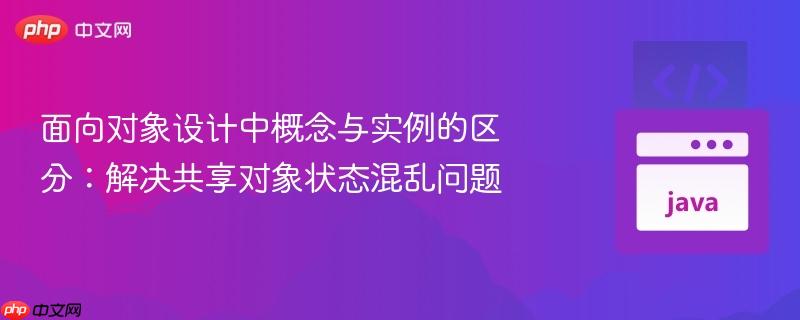
在面向对象设计中,当一个词语(如“car”)在日常语言中具有多重含义时,若在代码中未能明确区分其概念与实例,极易导致共享对象状态的混乱。本文将探讨这种“一词多义”问题,并通过引入`carcategory`和`car`两个独立类来清晰地建模,从而有效解决对象状态意外共享的问题,确保每个实例拥有独立可控的状态。
在软件开发中,我们经常将现实世界的概念映射到代码中的类。然而,某些词汇在不同语境下可能具有不同的含义,这种现象在语言学上被称为“一词多义”(Polysemy)。例如,“Car”一词既可以指代一种汽车型号(如“福特蒙迪欧”),也可以指代一辆具体的、拥有特定车牌号的汽车实例。当我们在设计类时未能明确区分这些含义,就可能引入潜在的问题。
考虑以下初始设计,其中Car类试图同时表示汽车的通用特性和具体实例的状态:
class Car {
int volume; // 油量
String model; // 型号
public Car(int volume, String model) {
this.volume = volume;
this.model = model;
}
}
class Person {
String name;
Car car; // 每个人都有一辆“车”
public Person(String name, Car car) {
this.name = name;
this.car = car;
}
public void decreaseVolume() {
if (this.car != null) {
this.car.volume--;
}
}
}假设我们创建了一个Car对象,并将其分配给多个人:
Car car1 = new Car(100, "Ford100");
Person p1 = new Person("Alice", car1);
Person p2 = new Person("Bob", car1);
// Bob的车油量减少
p2.decreaseVolume();此时,p2.decreaseVolume()操作不仅会减少Bob“拥有”的车的油量,也会同时减少Alice“拥有”的车的油量,因为p1.car和p2.car实际上引用的是同一个Car实例。这显然与我们期望的“每个人的车有独立的油量”这一语义不符。问题根源在于Car类模糊了“汽车型号的通用属性”和“特定汽车实例的当前状态”之间的界限。
为了解决上述问题,关键在于在设计阶段明确区分“汽车型号”这一抽象概念和“具体的汽车实例”这一实体。我们可以引入两个独立的类来分别表示它们:
以下是基于此思想的改进设计:
// 1. 定义汽车型号/类别
class CarCategory {
String brand; // 品牌
String model; // 型号
int maxVolume; // 最大油箱容量
public CarCategory(String brand, String model, int maxVolume) {
this.brand = brand;
this.model = model;
this.maxVolume = maxVolume;
}
// Getter methods
public String getBrand() { return brand; }
public String getModel() { return model; }
public int getMaxVolume() { return maxVolume; }
}
// 2. 定义具体的汽车实例
class Car {
CarCategory category; // 关联的汽车型号,强制在构造时指定
String serialNumber; // 序列号,唯一标识一辆车
int currentVolume; // 当前油量,这是实例的独立状态
String color; // 颜色
Person owner; // 车主
public Car(CarCategory category, String serialNumber, String color, Person owner) {
if (category == null) {
throw new IllegalArgumentException("CarCategory cannot be null.");
}
this.category = category;
this.serialNumber = serialNumber;
this.currentVolume = category.getMaxVolume(); // 初始油量可以设置为最大容量
this.color = color;
this.owner = owner;
}
public void decreaseVolume(int amount) {
if (currentVolume - amount >= 0) {
this.currentVolume -= amount;
} else {
this.currentVolume = 0;
System.out.println("Warning: Fuel tank is empty!");
}
}
// Getter methods
public CarCategory getCategory() { return category; }
public String getSerialNumber() { return serialNumber; }
public int getCurrentVolume() { return currentVolume; }
public String getColor() { return color; }
public Person getOwner() { return owner; }
public void setOwner(Person owner) { this.owner = owner; }
}
// 3. Person类与具体的Car实例关联
class Person {
String name;
// 一个人可以有多辆车,使用集合存储
// List<Car> cars;
// 或者如果一个人只有一辆主车
Car primaryCar;
public Person(String name, Car primaryCar) {
this.name = name;
this.primaryCar = primaryCar;
if (primaryCar != null) {
primaryCar.setOwner(this); // 确保Car实例知道它的owner
}
}
public void driveCar(int distance) {
if (primaryCar != null) {
int fuelConsumption = distance / 10; // 假设每10单位距离消耗1单位油量
System.out.println(name + " is driving " + primaryCar.getCategory().getModel() + " (SN: " + primaryCar.getSerialNumber() + ") for " + distance + " units.");
primaryCar.decreaseVolume(fuelConsumption);
System.out.println("Remaining fuel for " + name + "'s car: " + primaryCar.getCurrentVolume());
} else {
System.out.println(name + " does not have a primary car to drive.");
}
}
// Getter methods
public String getName() { return name; }
public Car getPrimaryCar() { return primaryCar; }
}现在,当我们创建并使用这些对象时:
// 定义一个汽车型号
CarCategory fordFocusCategory = new CarCategory("Ford", "Focus", 50);
// 创建两辆具体的汽车实例,它们都属于"Ford Focus"型号
Car aliceCar = new Car(fordFocusCategory, "SN001", "Blue", null);
Car bobCar = new Car(fordFocusCategory, "SN002", "Red", null);
// 创建两个人,并将各自的汽车分配给他们
Person alice = new Person("Alice", aliceCar);
Person bob = new Person("Bob", bobCar);
// Alice开车,消耗油量
alice.driveCar(100); // Alice's car fuel: 40
// Bob开车,消耗油量
bob.driveCar(50); // Bob's car fuel: 45
// 检查各自的油量
System.out.println("Alice's car current fuel: " + alice.getPrimaryCar().getCurrentVolume()); // Output: 40
System.out.println("Bob's car current fuel: " + bob.getPrimaryCar().getCurrentVolume()); // Output: 45通过这种设计,aliceCar和bobCar是两个独立的Car实例,它们各自维护自己的currentVolume状态。尽管它们都引用了同一个fordFocusCategory对象来获取型号信息,但对其中一辆车的油量操作不会影响到另一辆车。
对象关系设计: 在上述示例中,我们将Person与Car的关系设置为一个人拥有一辆primaryCar。如果一个人可以拥有多辆车,那么Person类中应该使用一个List
复杂属性和行为: 如果汽车的某些属性(如发动机调优、特殊改装)会改变其基于CarCategory的原始特性,设计会变得更复杂。此时,可以考虑以下策略:
强制关联: 在Car类的构造函数中强制要求传入CarCategory对象,确保每个汽车实例都明确其所属的型号,这有助于维护数据的一致性和设计的健壮性。
在面向对象设计中,清晰地识别和区分概念(如CarCategory)与实例(如Car)是避免共享状态混乱和实现独立对象行为的关键。通过为不同语义的实体创建独立的类,并建立它们之间的合理关联,我们能够构建出更符合现实世界逻辑、更易于理解和维护的系统。这不仅提高了代码的健壮性,也为未来的功能扩展和复杂性管理奠定了坚实的基础。
以上就是面向对象设计中概念与实例的区分:解决共享对象状态混乱问题的详细内容,更多请关注php中文网其它相关文章!

每个人都需要一台速度更快、更稳定的 PC。随着时间的推移,垃圾文件、旧注册表数据和不必要的后台进程会占用资源并降低性能。幸运的是,许多工具可以让 Windows 保持平稳运行。

Copyright 2014-2025 https://www.php.cn/ All Rights Reserved | php.cn | 湘ICP备2023035733号